In 18th century Europe, the middle class attained economic, social and political power. Consequently, the aristocracy was completely displaced by the middle class and changes in taste. Art and culture of the 18th century saw a transfer of leadership from one social class to another. In result of that, portraiture, which previously had sat lower in the hierarchy of genres, became more esteemed in society as history painting reached a “crisis” and the patrons wanted to fill an empty spot in the entrance hall of their new country house.
Portraiture became a way for artists to earn money outside of the Academy and it offered the middle classes a chance to play around with things like the notions of construction of identity. Art, then as now, was a luxury. The act of having your portrait painted was a sign of wealth and status, and portraits often used to elevate their sitters further up the social ladder. As one Swiss miniaturist once observed in 1755, “It is amazing how fond the English are of having their portraits drawn.”
Notably, women were able to use it as a platform to explore things like sexuality, fashion, status and notions of identity.
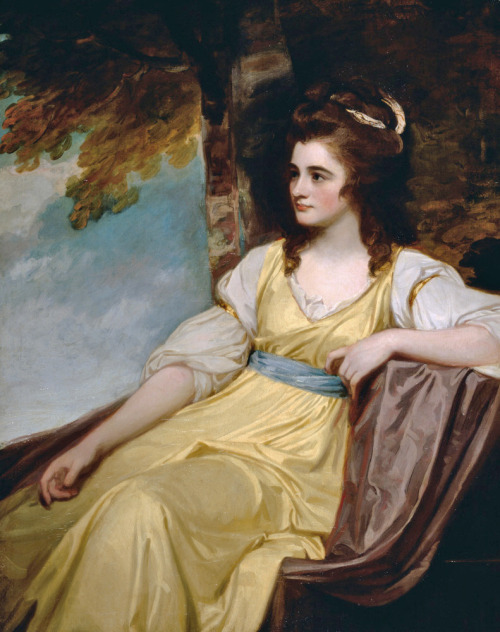 |
Hon. Charlotte Clive by George Romney (1734-1802)
1783
|
Joshua Reynolds (1723-1792) was one of the most popular painters in 18th century England. He was originally from Devon, England, but trained in London under Thomas Hudson. In 1749 he travelled to Italy, where he spent three years studying the Old Masters and cultivating new friends and patrons. His popularity amongst contemporary society is because of his ambition – his father had expressed that Reynolds would rather have been an apothecary than an “ordinary painter”, and Reynolds’s pupil, James Northcote, later observed that fame had always been his desire. The peak of his success was his election to President of the Royal Academy when it was founded in 1768
Reynolds was appointed court painter in 1784, but besides royalty, he also painted a number of upper-class bourgeois figures, actors, actresses and courtesans. One of Reynolds’s most well-known paintings of high society is his group portrait of the three Waldegrave sisters.
 |
| Ladies Waldegrave by Sir Joshua Reynolds (1723-1792) 1780-1 |
The portrait was commissioned by Horace Walpole, a great-uncle of the three women, and depicts (from the left) Lady Charlotte Maria (1761-1808), Lady Elizabeth Laura (1760-1816) and Lady Anna Horatia (1762-1801). Their lowered eyes, pale skin and white dresses all imply a becoming bashfulness and purity, which is further heightened by the highly executed lock and key of the table, as a locked drawer is a traditional emblem of virginity.
| Ladies Waldegrave (detail) by Sir Joshua Reynolds (1723-1792) 1780-1 |
The sisters embody contemporary ideals of feminine accomplishment, fashionability and beauty, depicting the different stages of the traditional female accomplishment, embroidery. The sisters’ activity of transforming raw threads of silk into a beautiful embroidered product allegorises the wider processes of refinement and transformation they themselves had undergone as they grew up. As Mark Hallett writes, as Reynolds evokes the ideas of classical beauty and the iconography of the Three Graces, it shows each sister in a different but equally flawless aspect.
All three were unmarried when the portrait was commissioned and were married soon after the painting was exhibited in 1781 – the portrait thus advertised their eligibility and desirability as future wives. It can also be argued that the body language of the first sister, Lady Charlotte Maria – who’s cocked her head up slightly as if she is aware of the presence of the viewer – helps bring the portrait out of the private and into the public sphere of marriage markets and exhibition spaces.
Around the time when the Waldegrave sisters’ portrait was exhibited, the focus on the most celebrated figures of urban society grew in intensity, partly thanks to a marked increase in the number of portraits Reynolds started sending to the annual exhibition - It is then no surprise that Reynolds’s association with the portrait played a role in its rise to popularity.
One of the ‘true’ celebrities of 18th century England, Georgiana Cavendish, Duchess of Devonshire, was also painted by Reynolds.
 |
| Georgiana Cavendish, Duchess of Devonshire by Sir Joshua Reynolds (1723-1792) c. 1775 |
Her celebrity status was confirmed by the fact that her physical beauty, rarefied social standing, hedonistic lifestyle and spectacular dress were relentlessly chronicled in the contemporary London newspapers.
The portrait represents the new cult of female representation in the 18th century, which shows that the woman can be self-possessed yet highly fashionable.
“Featuring prominently in this reportage [on the Duchess of Devonshire] were the new and extravangant modes of hair decoration associated in particular with the Duchess, which saw fashionable women building up their hair into ever-higher towers, thickened with powder, perfumed with pomade, and adorned with ostrich feathers. Graphic satirists were quick to exploit the possibility of such fashions offered for ridicule.” Reynolds Hallett, Celebrity and the Exhibition Space.
The portrait represents the new cult of female representation in the 18th century, which shows that the woman can be self-possessed yet highly fashionable.
 |
| THE DEVONSHIRE, or Most Approved Method of Securing Votes, by Thomas Rowlandson 1784 |
 |
| Lady All-Top, 1776 |
Nothing summarizes the influence of the Duchess as a 'fashion icon' as much as a collage of tall coiffures by The Duchess of Devonshire's Gossip Guide to the 18th Century.,, and these are just paintings by Reynolds alone!

The portrait of the Duchess subscribes to a narrative and iconography of celebrity which was typical of Reynolds – a full-length, single-standing figure posed in a classical style, dressed in a quasi-classical dress and adorning fashionable hairstyles, generally placed in a generalised outdoor setting that fuses the features of a traditional pastoral landscape with the details of a modern aristocratic state. This use of landscape and details of architecture to give us a sense of grandeur can also be seen in the upper right corner of the Ladies Waldegrave and the more general iconography can be seen in Lady Bampfylde and Elizabeth Gunning, Duchess of Hamilton and Argyll.
 |
| Lady Bampfylde by Sir Joshua Reynolds (1723-1792) c.1776 |
 |
| Elizabeth Gunning, Duchess of Hamilton and Argyll by Sir Joshua Reynolds (1723-1792) 1760 |
Engraving played a crucial role in the dissemination of Reynolds’s art and the creation of his international reputation. He relied heavily upon the print to promote his art, as Richard Godfrey observed: “No class of reproductive print has so close an association with a particular painter as that of the mezzotint with Reynolds.” The wide circulation of reproductive prints also means that a lot of individuals would have come in contact with them, thus increasing the celebrity status of a number of Reynolds’s sitters.
Reynolds’s portrait of the Duchess of Devonshire was also reproduced as a mezzotint. That, and the original portrait, fully participated in the urban economy of celebrity that encompassed newsprint, painting and printmaking. In the portrait, the articulation of the Duchess’s feminine beauty and her hairstyle – which she was infamous for wearing – caters brilliantly to the metropolitan fascination, accentuating exactly those characteristics of feminine desirability and fashionable extravagance that defined her vibrant public identity. Her dress and her background, typical to Reynolds, transform her into a figure of pastoral fantasy, a delicately classicised icon of aristocratic otherness that is appreciated by both the aristocracy and the London audience.
 |
| Georgiana Cavendish, Duchess of Devonshire by Valentine Green (1739-1813) after Sir Joshua Reynolds (1723-1792) 1780 |
The Duchess’s portrait is subsequently transformed into an ‘Exhibition Portrait’, which Robert W. Jones describes as “an image which is presented for a level of judgement and appreciation beyond that of the sitter, and as such participates in an economy of consumption which exceeds the private demands and expectations of its patron.” As the portrait of Elizabeth Gunning is also considered an ‘Exhibition Portrait’, it creates a precarious problem in regards to how the public would have viewed her. Robert W. Jones states that the contemporary society’s notions of what ‘Beauty’ meant set up a dichotomy of being ostracised and appreciated, which is indicative of the ambiguous and overdetermined nature of beauty in 18th century discourse, where ‘Beauty’ meant that you were not only a beautiful woman, but a figure whose existence was defined by their publicized and public attractiveness. Hence on one hand, she could be seen as a prostitute or an actress, on the other, she could be admired as a lady of high society. This implies that prostitutes and actresses were more or less represented in the same way as bourgeois women in portraiture.
Reynolds also painted Mrs Abington, a popular comedic actress. She is portrayed in the character of Miss Prue, a role from a comedy called Love for Love and it can be said that the artist has not depicted the sitter as a ‘traditional lady’.
 |
| Frances 'Fanny' Abington as 'Miss Prue' by Sir Joshua Reynolds (1723-1792) 1771 |
‘Miss Prue’ leans over a chair, with a dog on her lap and her thumb placed suggestively on her slightly parted lips. The highly detailed lace ruffles and fashionable dress indicates that her stage role ought not to detract from the fact that she was the real focus of attention. The point made by Reynolds was that, like Miss Prue, Mrs Abington is a woman with an appetite for sensual pleasure, and that her success in the role was allied to her own personality.
To a certain extent, the way Reynolds represented actresses was relatively different from the way he painted society ladies. Although, he painted a dramatic portrait, Mrs Musters as ‘Hebe’, which portrays a London socialite as the Greek goddess of youth.
 |
| Mrs Musters as 'Hebe' by Sir Joshua Reynolds (1723-1792) 1782 |
An equally theatrical portrait is Mrs Siddons - a well-known Welsh tragedienne of the 18th century - as the Tragic Muse, where Reynolds has portrayed the actress as Melpomene, the Muse of tragedy. Mrs Siddons took credit for coming up with the pose, but it is said to have echoed the one of prophet Isaiah from the ceiling of the Sistine Chapel, as well as Domenichino’s Saint John the Evangelist. William Vaughan states that basing the poses of his sitters on classical works of art ennobles the sitters by infusing them with the dignity of a work of art, and thus it elevates the social standing of the person depicted in the portrait.
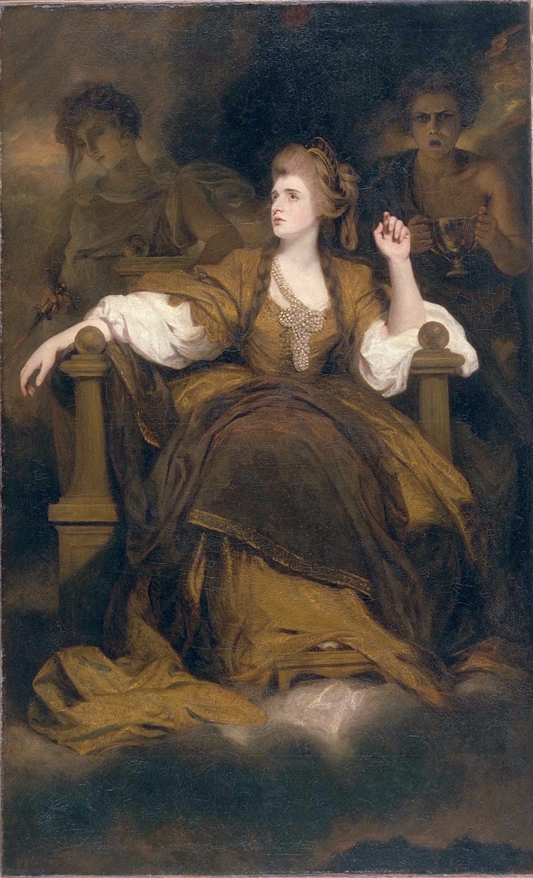 |
| Sarah Siddons as the Tragic Muse by Sir Joshua Reynolds (1723-1792) 1784 or 1789 (?) |
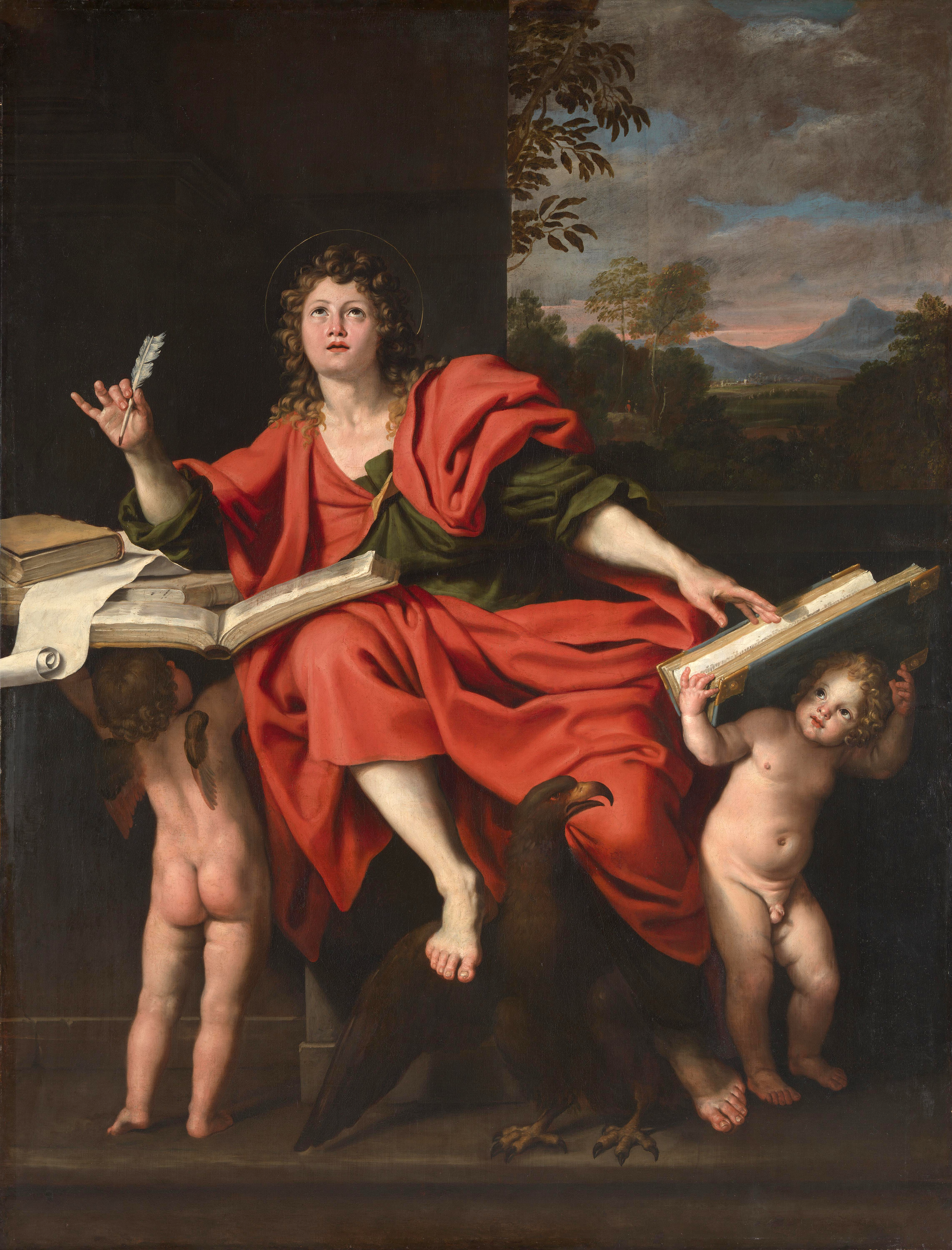 |
| St John the Evangelist by Domenichino (1581-1641) 1621-1629 |
.jpg) |
| Prophet Isaiah, part of the Sistine Chapel fresco by Michalangelo (1475-1564) ca. 1508-1512 |
As well as ennobling his sitters, Reynolds also had a great feel for theatricality, as can be seen in both portraits of Mrs Musters and Mrs Siddons. It can also be seen in a portrait of Mary Hale in which she is depicted in an allegorical bacchanal scene.
 |
| Mary Hale as 'Euphrosyne' by Sir Joshua Reynolds (1723-1792) 1762-4 |
The theatricality in the portraits can be linked to the rise of popular culture which Arnold Hauser argues happened because of the rise of the new and regular reading public. The increasing prominence of the well-to-do middle class, as Hauser writes, broke the cultural prerogatives of the aristocracy and showed a lively and every-growing interest in literature, thus becoming the new upholders of culture.
Play-acting was also a popular part of 18th century life, as grand country houses could easily be adapted for amateur theatricals. A painting like Mrs Musters as ‘Hebe’ shows how Reynolds makes the element of play-acting prominent. As Desmond Shawe-Taylor writes, her direct stare and smile and the execution of the painting – a simplicity of contour and a confident smudging of detail – lift her out of the timeless world of mythology and the ‘Grand Style’ of art, and into the midst of a Georgian parlour-game. There are other examples of artists who engaged with the ideas of play-acting in portraiture, for example, Daniel Gardner executed a group portrait of Elizabeth Lamb (Viscountess Melbourne), Georgiana Cavendish (Duchess of Devonshire) and Anne Seymore Damer as the three witches from Macbeth.
 |
| The Three Witches from Macbeth (Elizabeth Lamb, Viscountess Melbourne; Georgiana Cavendish, Duchess of Devonshire; Anne Seymour Damer) by Daniel Gardner (1750?-1805) 1775 |
Shawe-Taylor also talks about the rise of the masquerade ball in which you mask your true identity until an appointed hour, and are expected to maintain your chosen character in both speech and behaviour. It can be argued that the same concept is applied to in a number of Reynolds’s portraits. The concept of theatricality, self-fashioning and masquerade is prominent in the portraits of a courtesan called Kitty Fisher.
In 1758, a year before Reynolds first met Fisher, an anonymous writer observed that there was a “graduation of whore in the metropolis: women of fashion who intrigue, demi-reps, good natured girls, kept mistresses, ladies of pleasure, whores, park-walkers, street-walkers, bunters, bulk-mongers’; Kitty Fisher was no ordinary prostitute.
 |
| Kitty Fisher as Cleopatra Dissolving the Pearl by Sir Joshua Reynolds (1723-1792) 1759 |
In the late 1750s, London society was fascinated by the behaviour of the most celebrated courtesan of the age, Catherine ‘Kitty’ Fisher, whose exploits and affairs were trumpeted in broadsheets and ballads. In her portrait where she is depicted as Cleopatra, she suspends a large pearl above a goblet of wine, a motif taken from the figure of Cleopatra in Francesco Trevisani’s Banquet of Anthony and Cleopatra. Her hand forms an ‘O’ shape which signals a sexual act, symbolizing Kitty’s potent sexuality. The comparison to Cleopatra is particularly apt, as Cleopatra’s famous act of consuming a dissolved pearl in wine before Mark Antony compares fashionably with Kitty Fisher’s notoriously extravagant behaviour, markedly the incident when she ate a hundred pound note on a piece of buttered bread. For such women, publicity was essential in order to fuel the fantasy purveyed by their extravagant behaviour and Reynolds fanned the flames of public interest and boosted their celebrity even further. The fact that Kitty was portrayed in a character, like many other ladies of nobility, shows us that she was able to use portraiture as a platform to raise her status in social circles on to the same level as bourgeois women.
Another significant change in the 18th century was the development of the Enlightenment. Denis Diderot, a French philosopher, art critic, and writer, promoted the ideas and values of the movement - e.g. reason, judgement, lack of luxury, new intellectualism, the rise of science, combatting top-down power structure and superstitions and beliefs of the earlier time, like how to raise a child.
Jean-Jacques Rousseau took these ideas and wrote a book called 'Emile' in 1762, in which he discussed the ideas of education, improvement of the ordinary man, the natural state of childhood, and childhood being linked to the development of good society. It was also influenced by the writings of John Locke, who recommended things like loose clothes and fresh air for children in the many manuals on child-rearing. In the 1st half of the 18th century, most children were wet-nursed by country women, sometimes until they were 3 years old. At the same time, 40% of children died before they turned 6. Children also were considered to be savages in the previous century, and society was eager to correct their mistakes.
People started to believe that children learned through play, be it through playing by themselves or with an adult or an older sibling. This also became a popular theme in painting, and painters began to depict children with their parents, siblings, or on their own - to show the balance between play and learning. Children were finally considered to be separate from adults.
Reynolds, alongside other painters at the time, also painted images of mothers with their children. More specifically, his depiction of high-society women with their children conforms with Enlightenment ideas is a way that the mothers are engaging with their offspring, however, they still retain an image of grandeur as the setting and their wardrobe is the same as if they had been depicted in a regular portrait by Reynolds. One could argue that the purpose of these paintings - where you can observe a strong Madonna-like imagery - is to demonstrate to the viewer their qualities of motherly virtue as a high-society lady, setting the perfect example for other women to aspire to.
Another significant change in the 18th century was the development of the Enlightenment. Denis Diderot, a French philosopher, art critic, and writer, promoted the ideas and values of the movement - e.g. reason, judgement, lack of luxury, new intellectualism, the rise of science, combatting top-down power structure and superstitions and beliefs of the earlier time, like how to raise a child.
 |
| The Age of Innocence by Sir Joshua Reynolds (1723-1792) ca. 1788 |
People started to believe that children learned through play, be it through playing by themselves or with an adult or an older sibling. This also became a popular theme in painting, and painters began to depict children with their parents, siblings, or on their own - to show the balance between play and learning. Children were finally considered to be separate from adults.
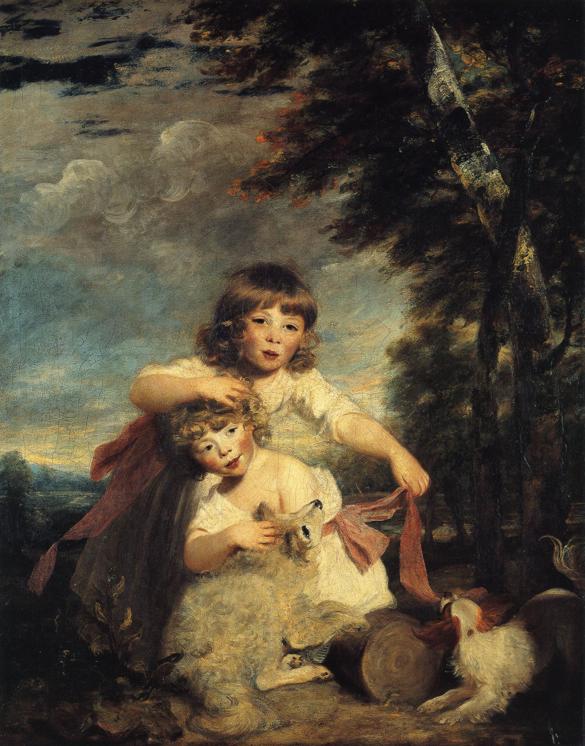 |
| The Brummell Children by Sir Joshua Reynolds (1723-1792) 1782 |
 |
| Lady Cockburn with her Children by Sir Joshua Reynolds (1723-1792) 1773 |
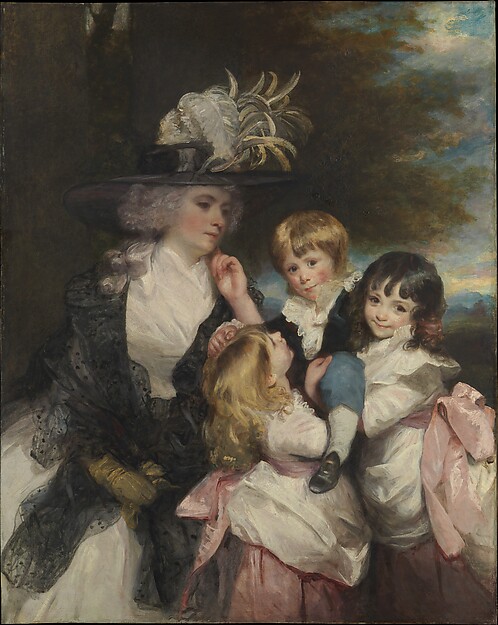 |
| Lady Smith (Charlotte Delaval) and her Children (George Henry, Louisa, and Charlotte) by Sir Joshua Reynlds (1723-1792) 1787 |
 |
| Duchess of Devonshire and her Daughter Lady Georgiana Cavendish by Sir Joshua Reynolds (1723-1792) ca. 1785 |
In conclusion, portraiture in 18th century England provided a wide platform for women to engage in a multitude of things, for example, like theatricality, feminity, and fashion, They could also play around with notions of construction of identity and the concepts of celebrity - and besides that, the changes in attitudes towards children and child-rearing meant that there was an increase of portraits painted where the sitter (the mother) is engaging with their child or children.
Joshua Reynolds, who I have been focusing on in this essay, used the power of art to transform something dross and material into magic, as can be seen in the paintings I have presented.
I would like to finish this post with a statement Marcia Pointon wrote in Strategies for Showing, where she writes:
Portraits don’t provide us with an ordering process reflecting social structures of 18th century England. In Reynolds’s work there is a strand of female portraiture that serves precisely the opposite function; these are images that provide for the expression of disorder, that establish a site of excess, of unruly passion and equilibrium.
SOURCES
Jones, Robert W. “‘Such Strange Unwonted Softness to Excuse’: Judgement and Indulgence in Sir Joshua Reynolds’s Portrait of Elizabeth Gunning, Duchess of Hamilton and Argyll.” Oxford Art Journal 18, No. 1 (1995): 29-43.
Mann, Emily. “Face Value.” New Statesman 713, vol. 15 (2002): 42-44.
Pointon, Marcia. Strategies for Showing: Women, Possession, and Representation in English Visual Culture 1665-1800. Oxford: Oxford University Press, 1997.
Postle, Martin, ed. Joshua Reynolds: The Creation of Celebrity. London: Tate Publishing, 2005. Exhibition Catalogue.
Shawe-Taylor, Desmond. The Georgians: Eighteenth Century Portraiture and Society. London: Barrie & Jenkins, 1990.
Vaughan, William. British Painting: The Golden Age. London: Thames and Hudson, 1999.
